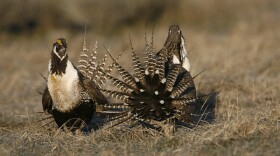Gov. John Hickenlooper released an executive order calling for a voluntary market-based protection system for the greater sage grouse.
The order is aimed at protecting the bird and keeping it off the endangered species list. The primary strategy Hickenlooper embraced is a voluntary program allowing ranchers and landowners to sell credits for habitat improvements to industries like oil and gas that have a negative impact on grouse habitat.
"We firmly believe that state-led efforts are the most effective way to protect and conserve the greater sage grouse and its habitat," Hickenlooper said in a statement.
The greater sage grouse is found in Northwest Colorado and in 11 Western states. Over the past century, its numbers have been dwindling. There were once as many as 16 million birds, now biologists say there are between .
In 2010, the U.S. Fish and Wildlife Service decided the sage grouse should be protected as endangered, but they the listing because they needed to prioritize saving other species instead.
If the sage grouse was listed as endangered, it would force a lot of changes on the lands where the birds live. Ranchers might have to change how they run cattle. Energy companies might not be able to drill or develop other mineral resources. Even wind farms, which disturb bird habitat, might be prohibited in certain parts of sage grouse territory.
Colorado and other western states don't want this to happen.
"...a decision by the federal government to list the greater sage grouse under the Endangered Species Act would have a significant and detrimental economic impact to the state," Hickenlooper said in his statement.
States have been to help the sage grouse and avoid a listing. Hickenlooper's order follows executive orders from governors in Montana, Wyoming and that also set up priorites for sage grouse protection at the state level.
Hickenlooper also directed state agencies to coordinate with Colorado Parks and Wildlife to reduce impacts to sage grouse and its habitat, take inventory and improve habitat within state lands. It requires oil and gas operators to mitigate for their disturbances to sage grouse habitat and orders the Colorado Oil and Gas Conservation Commission to track oil and gas activities in sensitive sage grouse habitat.
Some in the environmental community praised the order.
"This executive order underscores the need and opportunity for Colorado agriculture and industry to contribute to the state’s sage-grouse solution," Eric Holst, senior director of working lands at the Environmental Defense Fund, said in a statement.
But other groups urged caution. The group Backcountry Hunters and Anglers, which represents sportsmen in Colorado and the West, said the plan's voluntary nature meant there is less certainty habitat protection will actually succeed. In a statement, the group called for "...plans that don’t rely solely on voluntary mitigation measures."
The U.S. Fish and Wildlife Service has been ordered to reconsider whether the greater sage grouse should be protected under the Endangered Species Act. The for that decision is Sept. 30, 2015. Until then, states will continue to try to help the bird on their own.







